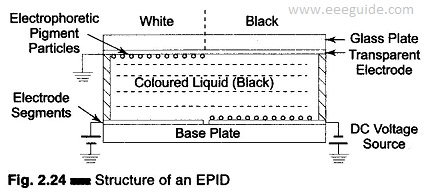Structure of Electrophoretic Image Display (EPID):
EPID – Electrophoretic Image Display is the movement of charged pigment particles suspended in a liquid under the influence of an electric field. This phenomenon has been utilised in electrophoretic image displays, as shown in Fig. 2.24.
The basic principle; fabrication and operating characteristics of a reflective type Electrophoretic Image Display (EPID) panel are as follows. These displays are characterized by large character size, low power dissipation and internal memory.
The relatively slow speed of these displays is a major limitation, particularly for use as a dynamic display. The life span of an EPID is a few thousand hours only.
The EPID panel makes use of the electrophoretic migration of charged pigment particles in a suspension. The suspension, 25 — 100 μ thick, which largely contains the pigment particles and a suspending liquid, is sandwiched between a pair of electrodes, one of which is transparent.
The application of a dc electric field, across the electrodes, as shown in Fig. 2.24 moves the particles electrophoretically towards either electrode, the movement depending mainly on the polarity of the charge on the particles. The reflective color of the suspension layer changes on account of this migration. EPID panels generally follow a segmented character format — typically 7 segment for numeric characters.
It is usual to have the transparent electrode as a common electrode. The back electrodes are generally segmented. Two such segments are shown in Fig. 2.24.
During the normal operation of the display, the transparent electrode is maintained at ground potential and the segmented electrodes at the back are given different potentials.
If the pigment particles are white and positively charged in the black suspending liquid, the application of a positive voltage to the chosen segment moves the pigment particles away from it and towards the transparent electrode. This is shown on the left side of Fig. 2.24. Pigment particles appear white in reflective colour as viewed through the transparent electrodes.
On the other hand, when a segment has a negative voltage with reference to the transparent electrode, the white pigment particles go towards it and get immersed in the black suspension. In this case, the viewer sees the reflection from the black liquid itself.
Colour combinations of both the pigment particles and the suspending liquid can be used to achieve a desired colour display.
Moreover, the colours between the displayed pattern and its background can be reversed, by changing the polarities of segment voltages.
In addition, the EPID panel has a memory, because the pigment particles deposited on an electrode surface remain there even after the applied voltage is removed.

